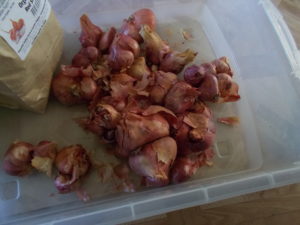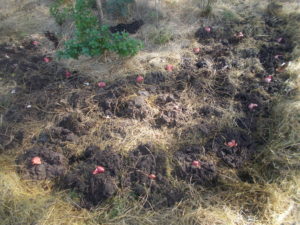French Red Shallot (Allium cepa var aggregatum) is a perennial onion. I first purchased few bulbs from Richters Nursery in Canada and planted in spring 2014. Each bulb divided into 2-3 big bulbs. Most of the bulbs I planted flowered. I harvested the bulbs in summer after the stalks turned brown and dried them with the stalks on in the shade for few weeks until it was time to plant them in fall. I planted them in our house as we moved that year. They grew well, flowered the following year and divided in 2-3 big bulbs as well. My goal was to keep planting them until I have enough for my year supply of onion and not buying onions at the grocery store. I harvested, dried and replanted in fall 2015.
Buy Your Herbs at Richters
I went along and purchased more French Red shallot bulbs from Peaceful Valley Farm to compare it to the one I have to make sure I have true shallot as they are few other varieties grown from seeds. French stated that true shallot is grown from bulbs not seeds.
I planted the bulbs received, in fall 2015.
They divided in spring into more than 3 bulbs but all of them were smaller than shallot I have in the garden. Since shallot is taught to be a perennial, I wanted to see how well they can thrive in my garden with neglect. So in summer 2016, I left the shallot bulbs in the ground unharvest. Summer 2006 was wet. Many rotted. Very few bulbs sprouted in fall. I mulch them right before winter. In spring 2017, they grew and multiplied. I didn’t harvested them on time and couldn’t locate them in the garden after the stalks turn brown and fell on the ground. At this point I don’t even know if I have any red shallots in my garden at all.
Project Nursery Giveaways!
French Red Shallot can be planted either in fall or spring. They can be harvested in late summer when the stalks turn brown or fall over. They are prone to rot if left in the garden in late summer. They are best harvested in summer, cured, and planted back in fall. They multiply into 3-6 bulbs. They last in storage but not as long as yellow potato onion but longer than Egyptian onion. They are easy to grow and don’t require a lot of maintenance. They rot easily in soggy area. To plant, separate the bulbs and plant 3-6 in apart with the tips above the ground. As they grow and multiply, they lift themselves off the ground and sit on the dirt. If planted in fall, mulch them to protect the roots from freezing and thawing during winter.
40% OFF Everything! Use Code: AFTERXMAS17
Cure the bulbs with the stalks on. I lay them flat in a carton box and dry in the shade for weeks or until it is time to plant in fall. At the end of the curing period I removed the bulbs form the stalks and store some in the basement in a box in a single layer. The rest is planted in fall around early November. Sometimes they flower and produce seeds. But true shallots are propagated through division of the bulbs. Small bulbs produce few big bulbs. Large bulbs produce a lot of small bulbs. I have not tried to sow their seeds. But in my opinion if they produce seeds, we should try to sow them to see what would come out of it. It could lead to new varieties. I would try to save these seeds and sow them. When we keep propagating through bulbs or cut off their flower stalks, we limit the variety to the only one we have and limit the plant to create new disease free varieties of its generations in our garden.
Project Nursery Holiday Gift Guide Giveaway!
I would be more mindful of that next season and purposely harvest my perennial onions seeds for sowing instead of just propagating them through division of their bulbs.
French Red Shallot is good for cooking and fresh eating. It is milder than regular onion. It is a good idea to grow them as a substitute to grocery store onion. They are not as maintenance free as you would think. You have to plant, harvest, cure and replant in fall or spring. But you only buy them once if you don’t let them rot in the garden.


